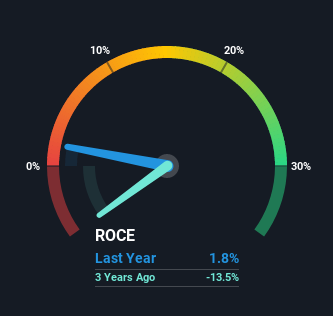- South Africa
- /
- Healthcare Services
- /
- JSE:AVL
Here's What To Make Of Advanced Health's (JSE:AVL) Decelerating Rates Of Return
If you're looking for a multi-bagger, there's a few things to keep an eye out for. Firstly, we'll want to see a proven return on capital employed (ROCE) that is increasing, and secondly, an expanding base of capital employed. If you see this, it typically means it's a company with a great business model and plenty of profitable reinvestment opportunities. Having said that, from a first glance at Advanced Health (JSE:AVL) we aren't jumping out of our chairs at how returns are trending, but let's have a deeper look.
What is Return On Capital Employed (ROCE)?
If you haven't worked with ROCE before, it measures the 'return' (pre-tax profit) a company generates from capital employed in its business. The formula for this calculation on Advanced Health is:
Return on Capital Employed = Earnings Before Interest and Tax (EBIT) ÷ (Total Assets - Current Liabilities)
0.018 = R13m ÷ (R1.1b - R333m) (Based on the trailing twelve months to December 2020).
Thus, Advanced Health has an ROCE of 1.8%. In absolute terms, that's a low return and it also under-performs the Healthcare industry average of 16%.
See our latest analysis for Advanced Health

While the past is not representative of the future, it can be helpful to know how a company has performed historically, which is why we have this chart above. If you're interested in investigating Advanced Health's past further, check out this free graph of past earnings, revenue and cash flow.
How Are Returns Trending?
The returns on capital haven't changed much for Advanced Health in recent years. The company has employed 113% more capital in the last five years, and the returns on that capital have remained stable at 1.8%. This poor ROCE doesn't inspire confidence right now, and with the increase in capital employed, it's evident that the business isn't deploying the funds into high return investments.
Another point to note, we noticed the company has increased current liabilities over the last five years. This is intriguing because if current liabilities hadn't increased to 31% of total assets, this reported ROCE would probably be less than1.8% because total capital employed would be higher.The 1.8% ROCE could be even lower if current liabilities weren't 31% of total assets, because the the formula would show a larger base of total capital employed. So while current liabilities isn't high right now, keep an eye out in case it increases further, because this can introduce some elements of risk.
In Conclusion...
In conclusion, Advanced Health has been investing more capital into the business, but returns on that capital haven't increased. It seems that investors have little hope of these trends getting any better and that may have partly contributed to the stock collapsing 86% in the last five years. In any case, the stock doesn't have these traits of a multi-bagger discussed above, so if that's what you're looking for, we think you'd have more luck elsewhere.
If you want to continue researching Advanced Health, you might be interested to know about the 2 warning signs that our analysis has discovered.
For those who like to invest in solid companies, check out this free list of companies with solid balance sheets and high returns on equity.
If you decide to trade Advanced Health, use the lowest-cost* platform that is rated #1 Overall by Barron’s, Interactive Brokers. Trade stocks, options, futures, forex, bonds and funds on 135 markets, all from a single integrated account. Promoted
New: Manage All Your Stock Portfolios in One Place
We've created the ultimate portfolio companion for stock investors, and it's free.
• Connect an unlimited number of Portfolios and see your total in one currency
• Be alerted to new Warning Signs or Risks via email or mobile
• Track the Fair Value of your stocks
This article by Simply Wall St is general in nature. It does not constitute a recommendation to buy or sell any stock, and does not take account of your objectives, or your financial situation. We aim to bring you long-term focused analysis driven by fundamental data. Note that our analysis may not factor in the latest price-sensitive company announcements or qualitative material. Simply Wall St has no position in any stocks mentioned.
*Interactive Brokers Rated Lowest Cost Broker by StockBrokers.com Annual Online Review 2020
Have feedback on this article? Concerned about the content? Get in touch with us directly. Alternatively, email editorial-team (at) simplywallst.com.
About JSE:AVL
Advanced Health
Advanced Health Limited, together with its subsidiaries, provides short-procedure surgical facilities and services in day hospitals.
Adequate balance sheet and slightly overvalued.
Market Insights
Community Narratives




